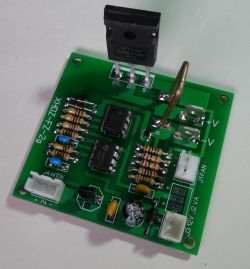Electronic load module 100V, 10A, 75W, commissioning, test
When testing, for example, power supplies, an electronic load is useful to, for example, force the flow of a specific current. In practice, light bulbs are often used quickly (which is a bad solution due to the low resistance of the cold fiber), resistors, or a random transistor on the heatsink, the base or gate of the transistor is controlled by an operational amplifier, or often without a feedback loop with an ordinary potentiometer. It is available on auction portals electronic load module priced ~ $ 8. In the description of the auction, we see the following parameters: maximum power 75W, continuous power 50W, maximum current 10A, maximum voltage 100V. On the board, we see a measuring resistor (in the form of a bent wire), a transistor IRFP250N, TL431, LM258, LM393. To start the artificial load, mount the transistor on a heat sink (preferably equipped with a fan), attach a 5-20k potentiometer ensuring current regulation, and connect a 12V power source.
The V- V + connector is used to connect the cables connecting the tested device,
in series in this circuit it is worth to turn on the ammeter to control the set current.
The 12V power supply is supplied to the J3 connector, the device consumes a current
The V- V + connector is used to connect the cables connecting the tested device,
in series in this circuit it is worth to turn on the ammeter to control the set current.
The 12V power supply is supplied to the J3 connector, the device consumes a current




Comments
I have such, DIY: https://www.elektroda.pl/rtvforum/viewtopic.php?p=14988589#14988589 Maybe you have a schematic for the reviewed copy, I wonder if there will be big differences, I also did it on a... [Read more]
There is no scheme, the description of the auction is usually tragic, this is a common feature of these cheap modules ... It is important that it works :) and does not generate oscillations ... The... [Read more]
@TechEkspert Let's take a look at the IRFP250N and take into account that in this system it works in DC mode ... unfortunately, the documentation does not often provide SOA for DC mode ... but... [Read more]
IGBT transistors are best suited for dissipating DC power. They have a much wider ch-ke SOA, so you can lose up to 300W in a housing like the transistor above. [Read more]
They don't necessarily have to be IGBTs. Anyway, it's better to give more transistors - in fact, apart from the transistor, we have few elements, in total an operational amplifier and a measuring... [Read more]
Found this pattern in less than a minute: Link . As you can see, someone took the trouble to draw it from a PCB. Who will now solve the puzzle related to the purpose of using the D1 diode and the threshold... [Read more]
Hello, If I am not mistaken, the output of the R13 resistor should be connected to GND and not to V- and the system works from about 0.7V. [Read more]
This is the scheme, but in a place where someone did reverse engineering ... and not at the seller / manufacturer. As for D1, this is a primitive way to get virtual mass? [Read more]